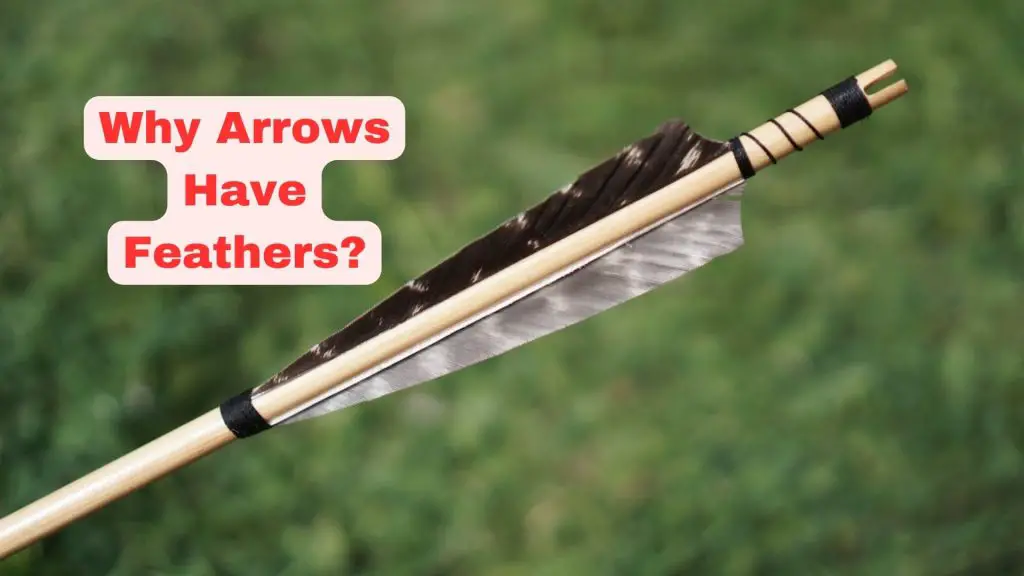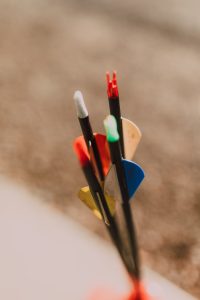The Surprising Science Behind Why Arrows Have Feathers!
Arrows are one of the most important tools in human history, used for both hunting and warfare for thousands of years.
A typical arrow is composed of a shaft, a pointed tip, and feathers or fletchings.
While most people understand the purpose of the shaft and tip, the reason for feathers on arrows may not be as well-known.
In this article, we will explore why arrows have feathers and their importance in archery.
At first glance, it may seem that the feathers on an arrow serve no purpose other than to make it look attractive.
However, this is far from the truth!

The feathers, also known as fletchings, play a crucial role in the flight of the arrow. Without them, an arrow would be much less stable and accurate, making it difficult to hit a target.
Historical context
To understand why arrows have feathers, we must look back at the history of arrow-making and the role of feathers in their design.
Arrows have been used for hunting and warfare for thousands of years, and they have undergone many changes and improvements in their design.
Early arrows were simply sharpened sticks, which were not very effective at hitting targets at a distance.
Over time, people began to add tips made of bone, flint, or metal to make them more lethal. However, it wasn’t until the addition of feathers that arrows became truly accurate and reliable.
The use of feathers on arrows dates back at least 2,500 years to the Scythian nomads of Central Asia. The Scythians were skilled horsemen and archers, and they used arrows with three feathers attached to the shaft. These feathers provided stability to the arrow and helped it to fly straight and true.
Feathers were also used in arrow-making by the ancient Egyptians, Greeks, and Romans.
In Europe during the Middle Ages, arrows were often fletched with goose or swan feathers, which were readily available and easy to work with.
Traditional arrow-makers would carefully select and trim the feathers to ensure they were the right size and shape for the arrow.
The feathers were attached to the arrow shaft using glue or wax, and they were arranged in a spiral pattern to provide maximum stability and accuracy.
Scientific explanation: Why Arrows Have Feathers
While the historical context provides us with a glimpse into the cultural significance of feathers on arrows, it is the scientific explanation that helps us understand the true function of fletchings.
Feathers provide stability to an arrow by creating drag against the air as it flies through the air.
This drag helps to slow down the rotation of the arrow and keep it pointing forward, making it much more accurate.
Additionally, feathers help to keep the arrow in a straight line, preventing it from veering off course.
The aerodynamics of an arrow in flight can be quite complex, but there are a few key principles that help explain why feathers are necessary.
When an arrow is shot from a bow, it begins to rotate around its longitudinal axis due to the way it is released. This rotation is known as arrow spin, and it can cause the arrow to veer off course if it is not properly stabilized.
Feathers on an arrow create what is known as a “drag crisis” when the arrow is first released from the bow. This drag crisis causes the arrow to slow down, which in turn slows down the rotation of the arrow.
As the arrow begins to slow down, the feathers create a vortex of air behind them, which helps to keep the arrow pointing forward. Once the arrow is stabilized, the feathers continue to play an important role in keeping it on course.
Also, The feathers act as vanes, creating a small amount of lift that helps to counteract the force of gravity pulling the arrow downward. This lift helps to keep the arrow in a straight line and prevents it from dropping too quickly.
The size, shape, and orientation of the feathers on an arrow can all have an impact on its flight characteristics.
In general, longer feathers provide more stability and accuracy, while shorter feathers offer less drag and more speed.
The angle of the feathers can also affect the flight of the arrow, with a slight offset producing a small amount of spin that can help to stabilize the arrow in flight.
In modern archery, feathers are often replaced with plastic vanes, which offer similar aerodynamic benefits without the fragility of natural feathers.
However, traditional archers still prefer natural feathers for their authenticity and historical significance
Can other types of fletching be used in place of feathers?

Yes, there are other materials used for fletching instead of feathers.
While feathers have traditionally been the most popular material, modern archery has seen the rise of alternative materials.
One of the most popular alternatives to feathers is plastic vanes.
Plastic vanes offer several advantages over feathers, including their durability, consistency, and resistance to weather conditions. They are also easier to maintain and less expensive than feathers.
Other materials that have been used for fletching include paper, silk, and even leaves. These materials have been used primarily for decorative purposes or in situations where natural materials were not available.
In recent years, there has been a resurgence in the use of natural materials for fletching.
For example, some traditional archers use turkey feathers, while others use the feathers of other birds such as swans or geese. Some archers have even experimented with fletching made from animal fur, such as beaver or squirrel.
In addition to the material used, the shape and size of the fletching can also vary.
Some archers prefer longer fletching for greater stability, while others prefer shorter fletching for greater speed.
The orientation of the fletching can also be varied, with some archers preferring a straight orientation, while others prefer a helical orientation for greater stability.
Cultural significance
While feathers on arrows have a clear scientific function, their cultural significance is equally important. Feathers have played a significant role in the cultures of many societies throughout history, and this has been reflected in their use in arrow-making.
In many Native American cultures, for example, feathers were seen as having spiritual power.
They were believed to have the ability to guide the arrow to its target, and they were often used in religious ceremonies.
Different types of feathers were chosen for their symbolic meanings, with eagle feathers being the most highly prized for their association with strength and power.
Feathered arrows have also been used in traditional archery competitions around the world.
In Japan, for example, archers shoot at targets with long bamboo arrows that are fletched with feathers.
The use of feathers in these competitions is not just a nod to tradition, but also a way to ensure the accuracy and stability of the arrows.
In addition to their practical and cultural significance, feathers on arrows have also played a role in the development of artistic expression.
Many traditional arrows were decorated with intricate designs, including painted feathers, which were used to create intricate patterns and designs on the arrow shaft.
Feathers have also been used to create unique arrow designs.
In the Pacific Northwest, for example, Native American artisans created arrows with feathers woven into intricate patterns, creating beautiful and functional pieces of art.
In modern times, feathers on arrows have continued to be an important symbol in popular culture.
From Native American headdresses to tattoo designs, feathers have become an iconic image that represents freedom, strength, and individuality.
The cultural significance of feathers on arrows is deeply rooted in history, spirituality, and artistic expression.
They have played an important role in the cultures of many societies around the world, and their continued use in traditional archery competitions and as a symbol of individuality shows their enduring importance.
Conclusion
In conclusion, arrows with feathers are an essential part of archery and have been used for centuries for both practical and cultural reasons.
While the historical context of feathers on arrows speaks to their cultural significance, the scientific explanation demonstrates their critical function in the stability and accuracy of an arrow in flight.
Feathers create a drag crisis, which slows down the rotation of an arrow and keeps it pointing forward. They also act as vanes, providing lift and countering the force of gravity, helping to keep the arrow in a straight line.
The size, shape, and orientation of the feathers can all impact an arrow’s flight characteristics, with longer feathers providing more stability and shorter feathers offering more speed.
Beyond their practical use, feathers on arrows hold cultural significance. In many societies, feathers have been associated with spiritual power, and different types of feathers have been chosen for their symbolic meanings. Feathers have also been used in traditional archery competitions and have been an important element in artistic expression.
While plastic vanes have replaced feathers in modern archery, traditional archers continue to use natural feathers for their authenticity and historical significance.
Moreover, The feathered arrow represents a unique combination of cultural significance and practical necessity, making it an enduring and meaningful aspect of archery and human history.
